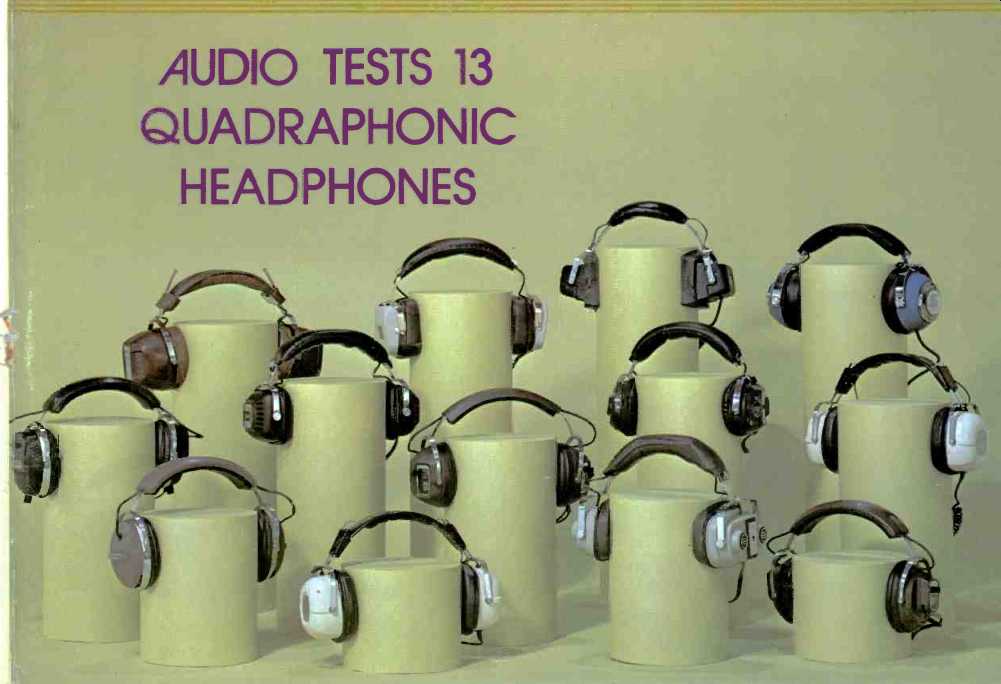
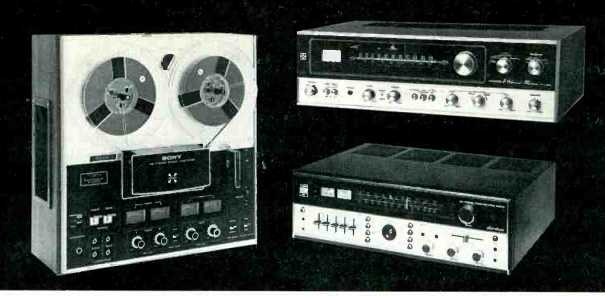
As far as we know, the first quadraphonic headphones were described in these pages in June 1970, by one Jon Fixier. Figure 1 (below) shows the original patent specifications.
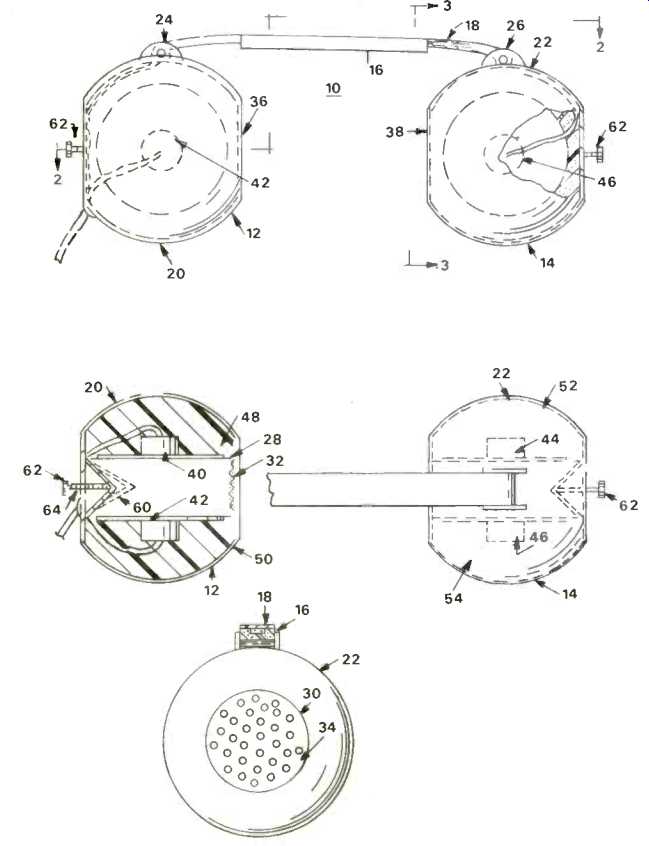
The front and rear units are mounted back to back with the sound coming from the same opening. Another tape was shown with the two transducers mounted side by side.
Well, ever since then experts and would-be experts have been arguing about the concept. Some say 4-channel headphones cannot possibly work; some say, well, if they do work the effect is purely psychological. It's all in the mind . . . Others, particularly those who make them, are full of enthusiasm and we hear about "breathtaking realism", "the ultimate in fidelity" and so on. Howard Souther, of Koss is more cautious. He says, "Even with two-channel headphones, what the listener hears is something larger, more dramatic than real life. We never claimed that we could reproduce sounds from the rear but we create a three-dimensional effect to fool the brain which picks up auditory clues and recreates reality." He went on to say, "... every acoustical engineer knows that the head must be free to move to pin point the sounds behind the listener." This is true: If you cover one ear you can still locate sounds from the rear but not very accurately. Location is performed by time, amplitude and phase differences between the two ears as well as by the `shadow effect' caused by the head itself. All this information is applied to the brain which functions like a computer to signal the sound location.
If sounds were fed to both ears via four closely spaced transducers, would there be enough separation to fool the brain? We decided to find out by a series of tests and so we assembled a listening panel of five with the 14 headphones now available. Our signal sources consisted of a sine-square wave generator, white noise and a Pioneer 4000 quadraphonic receiver and a Sony 277/4 tape deck.
The 4000 has switched positions for SQ matrix, Regular matrix and discrete. The SQ matrix is a semi-logic type and so a Fisher 504 receiver which has a non-logic SQ matrix was also used.
Test 1. Sine wave signals ranging from 400 Hz to 8 kHz were applied to the front and rear of one side of the headphones. With all phones it was not possible to tell which transducer the sound was coming from. In other words, the score was no better than 50% accurate.
Test 2. As above, but repeated with square waves. The score was slightly better at 60%. Not considered conclusive.
Test 3. This one gave us some positive results. We used a white noise signal and the score increased to an average of 75% with the Clark, JVC, Lafayette, Realistic and Mura receiving the highest marks.
The phones were reversed with the same results in most cases.
Test 4. Similar to Test 3, but repeated with all four channels in operation. Results were substantially the same. It would seem that the differentiation is due to the asymmetrical shape of the ear-the signal from the front transducer going down the ear canal and the rear signal passing across the ear with consequent minute frequency and phase changes.
Test 5. The final test-probably the most important one-took a considerable amount of time (and produced a near-mutiny from the panel). It involved listening to various musical selections from 4-channel tapes, SQ, Sansui and EV discs which were transferred to tape for convenience.
Using the rear channels only, the sound image appeared between the ears in the center of the head. Adding the front channels widened the image, moving it forward with an increase in bass response. Obviously, results were very much dependent on source material. Four-channel tapes, especially Enoch Light's Project 3, gave the best results, although we were not unanimous on this point. Some items sounded better with the Fisher non-logic decoder as the sudden shifts with the Pioneer logic proved somewhat disconcerting. The 14 units varied considerably in overall sound quality but all were considered superior in the 4 channel mode. There was a much greater impression of depth and spaciousness hard to define--in some cases the impact was quite startling. The sound image produced by two channel headphones is quite different to that given by two loudspeakers-one reason is that both ears hear both loudspeakers. In the same way, 4-channel headphone sound is not what you hear from four loudspeakers. You may like it or you may not. Rock lovers seem to enjoy the excitement, the stunning impact of a group playing away in their heads, but if your musical tastes lie in other directions, listen before you buy. Incidentally, we found the sound to be more natural with a slight blending of the front channels.
Some receivers have a control for this purpose-but make certain that it operates only on the front channels.
For the second part of the tests, the headphones were passed to C. G. McProud who carried out measurements using an acoustic coupler. We must emphasize that the curves shown are relative as the artificial ear or coupler does not duplicate the characteristics of the human ear.
Several standards are in use and a IEEE committee is trying hard to establish more accurate standards that will find international acceptance.
How they were measured
All the response curves were measured in the same manner. Each was fed from a 12-watt amplifier-solid-state-in series with a 100-ohm resistor to simulate the typical headphone jacks in a receiver. The signal voltage was set at 3.0 at 1000 Hz, and the swept a.f. signal was provided by a Bruel & Kjaer QR-2009 record, sweeping from 20 to 20,000 Hz in a period of 50 seconds.
The phones were placed on an artificial ear (a shop-made one, and not necessarily "absolute" but still comparative) into which was mounted an AKG C-451E condenser microphone with an omnidirectional cartridge. Its output was fed into the condenser microphone jack of a Justi-Meter III and the response recorded over the sweep-frequency range.
Each pair of phones was subjected to four cycles-left front, left rear, right front, and right rear. The reference on the chart recorder was set at center scale for all phones except the Mura, which was somewhat lower in sensitivity at 1000 Hz compared to its overall loudness.
Sound pressure level (SPL) was measured at 1000 Hz in comparison to another pair of phones which had a sensitivity of 92 dB when fed with the standard 3-volt signal. Isolation has been measured in the past by feeding a 400-Hz square wave into the amplifier, reproducing the output on a loudspeaker and measuring the output without the phones on the artificial ear and comparing it with the output with the phones in place on the ear. For all the phones in this group, the isolation was better than 20 dB, so no figures are presented for each separate pair.
The Mura phones mentioned indicated a lower SPL than most of the others. Observation of the response curve will show that 1000 Hz is considerably lower than the overall sound level, which accounts for the lower-than-average figure for SPL. All curves were run at the "slow" writing speed, which is 12 dB/sec. At the "fast" position-approximately 40 dB/ sec, the variations are not unlike those from loudspeaker response curves run in a room-with lots of sharp peaks and valleys.
In some cases, level differences between left and right phones could have been corrected with the controls on the phones themselves, but differences between front and rear provided for no adjustment.
------------------

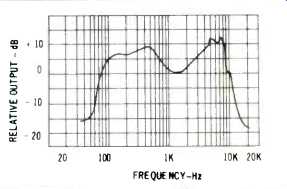
Clark/4CH-A Four-Channel Phones
SPL: 74 dB, Isolation: 13 dB
These phones are the most unusual in appearance, consisting of very wide black plastic cups, horizontal in shape and measuring 4 1/4 in. wide by 2 3/4 in. high and 2 1/4 in. deep. These are fitted with exceptionally soft molded foam cushions 5 1/4 by 3 1/2 inches, and curved to fit the side of the user's head. Weight is 23 oz. Sensitivity is lower than most, and isolation is somewhat less than the other models tested, probably due to the plastic cups which were especially sensitive to touch. The headband is metal, readily adjustable, and covered with a foam-filled vinyl pad, making the phones comfortable to wear. The round coiled cord, in black, extends to 12 feet, and is fitted with a white stereo plug for the front units, and a red stereo plug for the rear. Overall sound was smooth with better apparent front/rear separation than most.
The small unit shown with the phones is a decoder, Model DC-2A so 4-channel sound can be had from a normal two channel input. It consists of a plastic box measuring 2 1/4 inches wide by 2 1/4 long and 1 1/4 deep with two stereo jacks mounted on it, one labeled front and the other rear. An 18 inch cord is attached with a single stereo plug at the end. Insertion loss is negligible as the matrix is a passive arrangement using two hybrid transformers. Mixing ratio is said to be 0.7:1. In practice, the results were very similar to those given by the Pioneer regular matrix. A slight blending of the front channels was preferred with some program material.
Price: headset, $80; with decoder, $95.
------------------
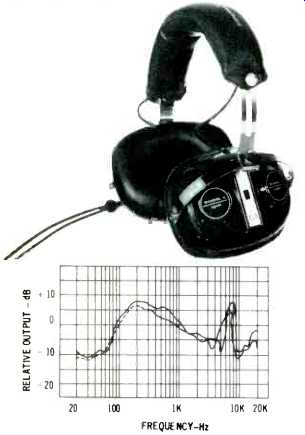
JVC Model 5944 4-Channel, 2 Channel Compatible Headphones
SPL: Front, 82 dB, rear 79 dB.
These phones specifically indicate that there are two separate transducers, and they are placed in a horizontal position, so the headset appears to be broad, as compared to most in which there are two transducers in each cup, but externally the phones appear identical with conventional stereo models.
Nominal input is 1 mW; maximum is 100 mW. Diaphragms are 11/2" in diameter, with 3/4" voice coils. The two transducers are tilted slightly together at an angle of 145 deg. The headband is well padded with black vinyl covering over foam. Adjustment screws retain the sliding cup bails. The cups are glossy plastic in a dark gray-almost blackwith foam-filled vinyl pads measuring 5 in. wide by 31 in. high. Weight is 19 oz. The phones are equipped with a 6-ft. 7-in. straight cord with two plugs, each with a small plastic tag to indicate "Ch. 1 (L) and Ch. 3 (R)" or " Ch. 2 (L) and Ch. 4 (R)" for front and rear signals respectively.
For listening to 2-channel (conventional stereo) either plug may be inserted into the headphone jack, or an optional twin cord (TWC-1) may be used to parallel the front and back units to provide the same volume at a lower level and with consequent lesser distortion.
Each cup has a slide switch which is marked "Phase Norm/Rev," which enables some interesting effects to be obtained. In some cases the reverse phase position seemed to widen the stereo image, in others it had the impression of constricting it. For instance, SQ records sounded better with the controls in the normal position, but ordinary records played via SQ matrix, sounded better with the phase reversed.
Price: $49.95.
---------------
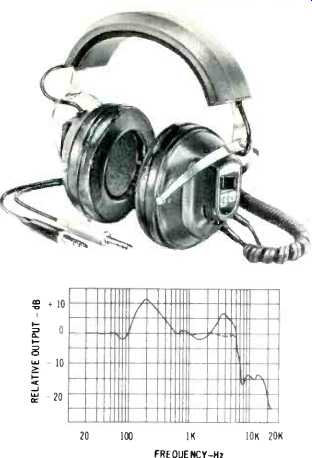
Koss KO/747Q 4-Channel Quadraphone
SPL: Front, 99 dB; rear, 95 dB.
Similar to several other Koss phones is the KO/747Q, which has a brown plastic headband cover with foam padding, and with brown plastic earcups and brown vinyl fluid-filled pads measuring 4 1/4" x 3 3/4".
Weight is 22 oz. Each cup has a rotary-type disc volume control, and the left cup is fitted with a rocker switch for 4-channel or 2-channel listening, the two elements in each cup being paralleled in the 2-channel position. A double 10-foot coiled cord is provided with the usual two stereo plugs, one black for the front channels and the other gray for the rear.
Price: $55.00.
Channel matching was within 2 dB except between 3 and 6 kHz.
-------------------
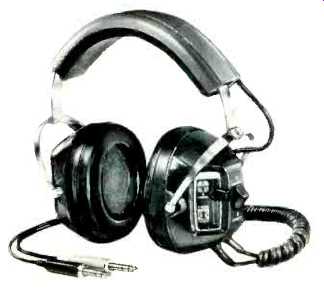

Koss K/6LCQ 4-Channel Quadraphone
SPL: 92 dB. These phones are somewhat less expensive than the K2+2 described previously, possibly because of the absence of the plastic carrying case as one reason. They have a brown plastic headband cover, foam padded. The cups are brown plastic, with foam-filled cushions measuring 4 1/4" x 3 3/4". Weight is 22 oz. Each cup is provided with individual balancing slide-type controls which permit balancing front and rear and right to left for optimum listening pleasure. In addition, the left cup has a rocker switch labeled 4-chan and 2-chan. In the 2-chan position, the driver units are paralleled to double the radiating area for increased bass range efficiency. The left channel showed a rise from 400 Hz down, increasing to +5 dB at 100 Hz. Overall sound was smooth and easy to listen to.
A 12-foot coiled cord is provided, emanating from the left earcup (as usual), and two stereo plugs-one black for front in 4-channel listening or for the input for stereo, and the other gray for the rear channel when listening to four channels.
Price: $39.95.
------------------
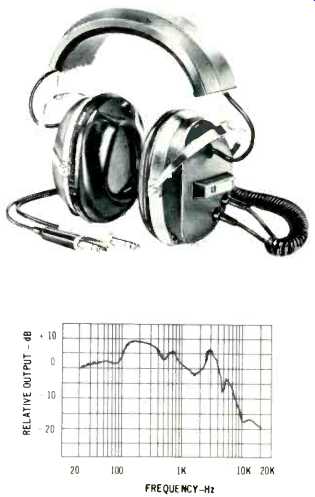
Koss PRO-50
SPL: 98 dB. Channel matching very close.
Stepping up again in the price range is the PRO-50. A brown plastic headband cover is foam padded and, of course adjustable. The cups are brown plastic, with liquid-filled vinyl pads 41/2" high by 3 1/2" wide. The left cup is fitted with a 4-chan/2-chan rocker switch, and individual volume controls on the two cups permit adjustment.
These controls take the form of serrated disks labeled 0 to 10 and permit balancing the outputs of the two phones.
The phones are fitted with a 12-foot coiled cord with two stereo plugs-black for front and gray for rear. For stereo listening, the rocker switch is flipped to the "2" position, and only the black plug is used. Channel matching was very close and sound was well balanced.
The volume controls were judged easier to use than other types. Weight is 22 oz. Price: $70.00
----------------
Koss K2+2 Four-Channel Dynamic "Quadraphones"
SPL: front, 93 dB: rear, 96 dB Koss was undoubtedly the original high-fidelity headphone manufacturer, if we are to exclude some professional units such as RCA's MI-3453 or some Western Electric models from the early sound moving picture days. And Koss probably has more models than anyone else. The K2 + 2 combines two transducers-dynamic, of course-in each cup, and in addition provides volume controls in the cups to control the front unit level-a convenience for four channel listening. In addition, there is a "4-Chan/2-Chan" switch which parallels the front and rear units in both phones for conventional stereo listening.
These phones have a black plastic headband cover, well padded with foam. Cups are black plastic, with metal trim, and the fluid-filled ear cushions for user comfort. These pads measure 3 1/2" wide by 4 1/2" high. A small knob on the bottom of each cup controls the front unit volume, and the 2/4 switch is a rocker type on the left cup.
The double coiled cord extends to 10 feet, and a black plug is used for the front-channels 1 and 3-and a gray plug for the rear-channels 2 and 4.
The Koss K2 +2 phones are packed in an attractive plastic case 14" x 10" x 6", with foam padding inside, die-cut to accommodate the phones and hold them securely in the case.
Weight is 22 oz.
Price $85.00.
Channel matching was very close and overall sound was one of the smoothest of those tested.
--------------------
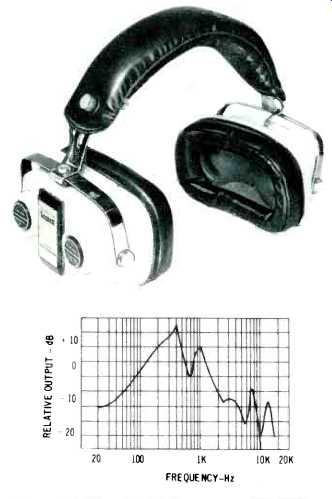
Lafayette F-4400 Four Channel Stereo Headphones
SPL: 88dB, single flat steel adjustable headband, covered with foam-filled black vinyl pad. Horizontally mounted separate transducers in gray plastic cups 5 1/4 x 3 1/2 in., with ample permanently attached foam-filled black vinyl covered pads. Sound emanates from small acurate openings near the ends of a solid plastic diffuser, thus directing the sound from further to the front and rear than in most types. Small slide switch on left phone converts from four-channel operation to two channel for conventional stereo listening. Cord is parallel flat type, 911 ft. long, terminating in two molded stereo plugs-black for front and gray for rear, with designation molded in the bodies of the plugs in addition. Weight is 28 oz.
According to the leaflet enclosed with the phones, a special built-in frequency dividing/phase shifting network will produce a 4-channel effect from a 2-channel source when the mode switch on the phones is set to "2-CH". We found it certainly gave a more spacious kind of sound but it was generally considered inferior to a regular matrix decoder. Price: $39.95.
------------------
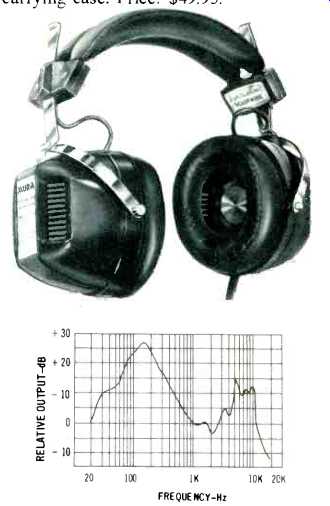
MURA QP-300 Quadrasonic Headphones
SPL: 67 dB.
With a brown vinyl covered pair of bands, the Mura QP-300 offers a different method of tightening the pressure against the ears. The cups are of brown plastic, with lighter brown foam filled pads. The cups are deeper than usual, measuring 4" x 33/4" at the pads, but with a depth of 4 inches over the pads. The cups are vented at two sides on the rear with louver-like openings as part of the acoustic circuit. Weight is xx oz.
Two units are used for each channel, that's right-a total of eight! The low frequency transducers are loaded by a pressure plate and slots conduct the sound to openings placed near the treble units mounted on each side. Overall sound was a little too bass-heavy for most of the panel but balance could be restored by judicious use of the tone controls.
The phones are fitted with a flat cord 7 feet long, and are packed in a vinyl zippered case 10 in. square by 4 in. high, lined with blue felt and sufficient padding to make an effective carrying case. Price: $49.95.
------------------
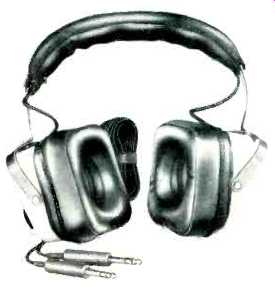
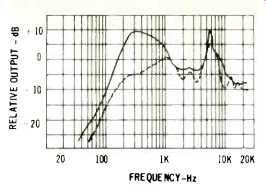
Teledyne Ph-220 4-Channel Headphone
SPL: 79 dB. This is another "side-by-side" unit similar to the JVC and the Mura models. However, in the Teledyne, the transducers are mounted in a straight line. The brown vinyl-covered foam-filled pad has extendable gold finished metal bands slotted to accommodate the thumbscrews which secure the phones at the desired position. The light buff earcups are fitted with brown vinyl foam-filled pads 4 1/4 x 3 3/4 in., the former dimension being width.
These phones have an-eight-foot flat cord with two stereo plugs and black plastic indicators for front and rear. Also furnished with the phones is a twin connector consisting of a stereo plug attached to two stereo jacks for paralleling the front and rear units for stereo listening. The Teledyne PH-220 is sold by Olson Radio Corporation. The left channel had a reduced response below 1000 Hz. Apparent separation was one of the best. Weight is 22 oz. Price: $44.98.
-------------------
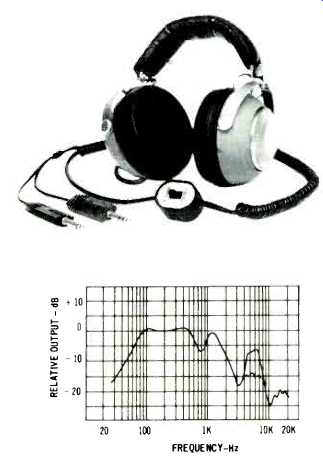
Stanton "Dynaphase Sixty-Five/ Four C"
SPL: 95 dB.
Differing from the general run of headphones is the Stanton 65/4C model (to abbreviate). It has a black vinyl foam-filled headband cover, with adjustable bails to the two blue cups with chromed and plastic nameplates on the back of each. The ear cushions are large (4 1/4 x 4 1/4 inches) and foam filled with considerable depth so the overall depth of the cup and pads is 3 inches. A single round cord extends from the left cup for 24 inches where it enters a plastic switch box 1 1/4 x 1 3/4 x 1 in. to accommodate a slide switch labeled 4-chan and stereo, paralleling the units in the stereo position. A double coiled cord extends from the switch box and extends to 9 ft., terminating in two stereo plugs-one blue for the front and one black for the rear. These plugs are 1 in. wide x 2 1/8 in. long, and might present a problem if the headphone jacks are close together on the receiver. Weight is 19 oz.
A number of accessories are available optionally to provide for separate volume and tone controls for the two phones (four circuits)--two being required for four-channel listening. Also available as an option is a 25-foot extension coil cord. Overall sound was smooth with good balance. Styling and finish was one of the best tested.
Price: $64.95.
---------------
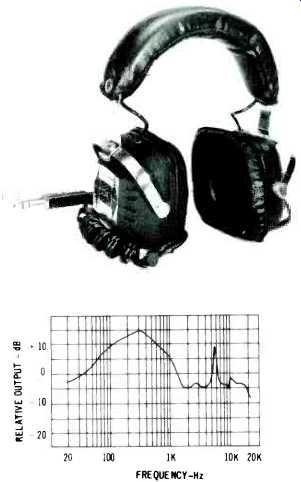
Realistic NOVA 44 Stereo/4-Channel Headphone
Radio Shack's entry into the stereo/ 4-channel field is this NOVA 44 model, which appears to be similar to the JVC, in that the two transducers are mounted side by side, thus making the earcups wider than high. A soft foam-filled vinyl headband cover--black in color--matches the black plastic cups and the black vinyl foam-filled cushions which measure 4 1/4" wide by 3 3/4" high. The units are again mounted at an angle--as in the JVC-but in the Nova the angle is close to 90 deg. The coiled black cord will extend to 15 feet, and is fitted with two molded plugs into which the "F" and "R" are molded with a square shank. Weight is 24 oz.
Bass response was judged rather too predominant but this could be corrected by the tone controls. Price $39.95.
(The Radio Shack Catalog Number is 33-1016.)
------------------------
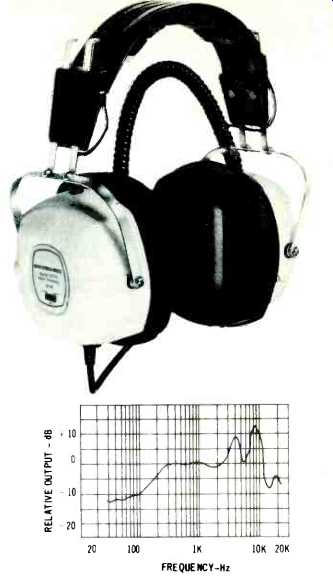
Superex QT-4 Four-Channel Stereophone
SPL: Front, 80 dB
With its vinyl-covered dual wire headband and adjustable slides, the Superex QT-4 is the first of this company's entry into 4-channel phones. The cups are of off-white plastic, with vinyl covered foam-filled pads, measuring 4 3/4 x 4 1/8 inches. Four identical and matched units are mounted in the phones, with a coiled black cord which extends to 15 feet. Two stereo plugs terminate the cord-one with a red identifying sleeve on the cord where it enters the plug to indicate the rear channels. Weight is 16 oz. Overall sound was smooth but lacking in bass.
Balance could be obtained by using the bass tone controls. Price: $65.00
-------------------
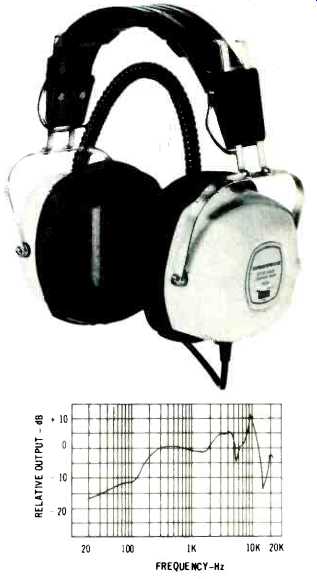
Superex QT-4B Quad-Tette Four Channel Stereophones
SPL: 80 dB. These phones are similar to the QT-4, but in addition to this similarity they are fitted with a tiny slide switch on the left phone to permit paralleling the front and rear units for conventional stereo listening. Weight is 16 oz.
Frequency response was found to be similar to the QT-4's and most of the panel preferred to use some bass lift.
Price: $50.00.
---------------------
(adapted from Audio magazine, Jun. 1973)
Also see:
The "Open-Aire" Principle in High Fidelity Headphones (May 1972)
Headphones around the house (May 1974)
Dual Impedance Headphone Circuit (May 1975)
Piezoelectric Headphones (May 1975)
= = = =